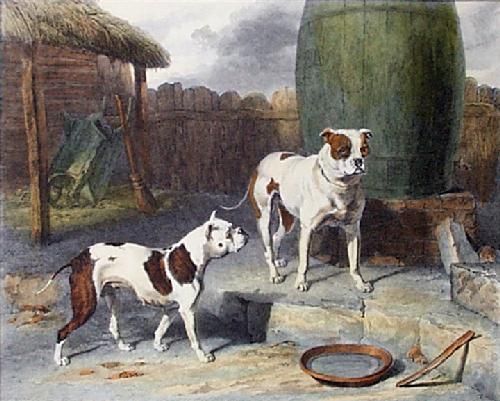Health
Is the English Bulldog a Doomed Breed?
A lack of genetic diversity in the English bulldog may spell its demise.
Posted August 3, 2016

I must admit that I have a fondness for the English Bulldog. It is not for their jowly looks (although some people find that their flattened square faces have an almost child-like appeal). Nor is it for their athleticism, since they have none — they tend to waddle and generally lack the ability to run, jump, or swim very effectively. My fondness for the breed has to do with their temperament. Almost all of them are friendly, patient, and quiet. Bulldog owners report that these dogs get along well with children, other dogs, and even the family cat. Bulldogs have a strong tendency to affectionately bond with members of a family, and rather than trying to chase the ball around the yard, their favorite athletic endeavor is to try to make their way up onto the sofa so that they can put their head in your lap. Thus it was with great dismay that I read the conclusions of a set of researchers who stated that "the English Bulldog truly is a breed in trouble." They go on to say that inbreeding "has brought the breed to a crisis point."
It is well known that over the course of their existence Bulldogs have been systematically genetically manipulated. For example, you never would have been able to predict today's dog, with its gentle and sociable temperament, given the Bulldog's history. They first appear on the scene in the mid-1600s. The "bull" in their name refers to the fact that the breed's original function was to compete in the sport of bull baiting in England. This was a betting "sport", where dogs were turned loose on a tethered bull. The objective was for a dog to latch onto the bull's nose and force it to the ground. The first dog to do so was the victor. This, however, was not an easy task and it was not unusual for a bull to maim or kill dogs are as it fought back by goring or trampling its opponents. Over time the dogs used for this task were bred to have massive heads and strong jaws, as well as a ferocious and savage temperament. Things changed in the mid-1800s when bull baiting was outlawed in England. Fortunately a number of people felt that Bulldogs might make good family pets, and to foster this they began to breed them to be gentler and more sociable. On the other hand their idea was that they wanted to produce a dog which looked fierce despite the fact that it was friendly and compliant. So they began to breed the dogs to meet a new, and some might say a distorted, notion of fashion. The new, non-fighting, English Bulldog had to have an even larger and more massive head, with a flatter face and more wrinkles. They were also to be shorter, wider and heavier.
For example look at the two English Bulldogs in the 1817 Abraham Cooper painting below.

Now look at a modern bulldog below with similar coloration. Notice that our contemporary dog has considerably shorter legs and is much stockier, more compact, and more sway backed. Perhaps most important is the shape of the face and head. Today's version is more brachycephalic, meaning that the face is considerably flatter, and there are also more loosely folded wrinkles on it.

Unfortunately all of these features are also associated with an increased incidence of health problems in the breed. The extremely flattened face is the source of major breathing problems, and the wrinkled and folded skin traps moisture and tends to get infected. The modification of the body shape has resulted in a high incidence of joint disease, most specifically hip and elbow dysplasia as well as ruptures in the spine. The list of problems goes on to include some invisible maladies, such as a weakened immune system which results in a higher incidence of allergies and greater susceptibility to infection and so forth. Given their current body shape it is difficult for these dogs to even reproduce without assistance. The majority of females must be artificially inseminated, and then because of their narrow hips relative to the head size of the puppies, birth usually requires the use of a Caesarean section. As you might guess the many health problems in Bulldogs results in a greatly reduced life expectancy. The most recent data suggests that the life span of the English bulldog now averages at only around eight years of age.
It is these health problems which motivated a new study that appeared in the journal Canine Genetics and Epidemiology*. The leader of the research team was Niels Pedersen, a professor emeritus at the University of California, Davis, School of Veterinary Medicine. The main objective of this research was to determine whether the English Bulldog retains enough genetic diversity to allow breeders to correct the abnormalities which are causing so many health problems in these dogs. Correcting the problems would involve selective breeding. Such breeding would target the elimination of the harmful, often recessive, genetic mutations which have accumulated. If there is enough genetic diversity then head shape, physical structure, and problems associated with the immune system can be corrected by carefully selecting sires and dams who are genetically more sound and will likely produce more healthier and more desirable pups.
By the standards of genetic research this was a reasonably sized study which looked at 102 registered English Bulldogs, plus an additional 37 English Bulldogs with known health problems obtained from the UC Davis Veterinary Clinic. Unfortunately the results of this investigation did not paint a hopeful picture. When the researchers looked at the overall genetic diversity among Bulldogs it was astonishingly restricted relative to other breeds of dogs. In fact the researchers discovered that almost 80% of the dogs tested were more closely related genetically than if their parents had been a brother and sister. This is a scary result, since populations that have lost genetic diversity are more likely to accumulate harmful and dysfunctional traits. Furthermore it means that there is not enough leeway or flexibility left to try to perform some kind of "reverse genetic engineering" to bring the breed back into health through selective breeding. This is simply because dogs with alternate, more favorable, genes are simply too rare in the population.
In an interview Pedersen said, "I think the English Bulldog in its present and worst state is doomed."
Is there any solution? The only way to increase genetic diversity is by adding new and different genetic material to the breeding pool. This would mean out-crossing Bulldogs with other similar breeds of canines. Such crosses might then provide the opportunity to weed out and replace some of the genes that are causing most of the health difficulties. The problem here is that the resultant dogs would be hybrids, and many breeders and kennel clubs would consider these hybrid pups to be a different breed. In other words the breeders would consider them to be mongrels — not Bulldogs.
The English Bulldog remains one of the most popular breeds because of that wonderful temperament that they have. However I am afraid that unless there is a will among breeders to improve the overall health of Bulldogs, and unless that is accompanied by an agreement from the various national kennel clubs to grant a bit of latitude to allow selective out-crossing, then the genetic diversity in the breed will continue to diminish. More genetic bottlenecks will appear, more harmful traits will accumulate, and if nothing is done it would not surprise me to find that a decade or two from now the median life expectancy of the English Bulldog will have been reduced to six years or less. Once that happens the popularity of the breed will plummet, fewer dogs will be bred, the genetic diversity will contract even further, and we will lose a wonderful breed of pleasant canine companions.
Stanley Coren is the author of many books including: Gods, Ghosts and Black Dogs; The Wisdom of Dogs; Do Dogs Dream? Born to Bark; The Modern Dog; Why Do Dogs Have Wet Noses? The Pawprints of History; How Dogs Think; How To Speak Dog; Why We Love the Dogs We Do; What Do Dogs Know? The Intelligence of Dogs; Why Does My Dog Act That Way? Understanding Dogs for Dummies; Sleep Thieves; The Left-hander Syndrome
Copyright SC Psychological Enterprises Ltd. May not be reprinted or reposted without permission
Data from: Niels C. Pedersen, Ashley S. Pooch and Hongwei Liu (2016). A genetic assessment of the English bulldog. Canine Genetics and Epidemiology, 3:6,DOI: 10.1186/s40575-016-0036-y




